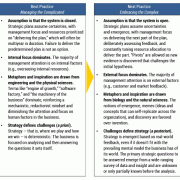CUTTER IT JOURNAL VOL. 28, NO. 11/12
We are constantly bombarded with the message that we are living through a period of unprecedented change; that technology is rewriting the rule book across all industries; that any organization that fails to fully master technology will become commoditized, obsolete, or extinct; and that the only possible solution to these challenges is to implement the latest technological miracle cure.
While we can discount the inevitable hyperbole — and, all too often, the self-interest — at the heart of these opinions, there is undoubtedly a foundational shift occurring in the information technologies that underpin our businesses and organizations. We have not yet found a consistent way to articulate this foundational shift; perhaps the closest we have come to a widely accepted definition is the categorization of business technologies into "digital" and "enterprise IT." Digital has become synonymous with customer-facing technologies that embrace the world of social, mobile, cloud, big data, and emerging technologies such as AI, while enterprise IT remains the de facto term for back-office and enabling technologies.
These two categorizations extend to different worldviews and ways of working, with their respective practitioners adopting a tribe-like mentality to self-identify. The internecine battle between these technology tribes is a pointless distraction for most large-scale organizations. For these businesses, the new digital technologies and approaches will need to leverage and exploit the over 20 years of investment in enterprise IT if they are to fully realize their transformational potential. New digital capabilities will need to build upon existing IT-enabled operational capabilities.
In this context, the scope of digital transformation needs to be widened to incorporate both the harnessing of emerging technologies and patterns and the genuine exploitation of legacy technologies and services. However, we should be careful not to confuse exploitation of legacy technologies with the application of so-called IT "best practices." Simply replacing old enterprise IT with new cloud enterprise IT by itself may not cut the mustard. We find this approach can often add to enterprise IT complexity (as not everything gets switched off as expected), and even the successful programs need to interact effectively with digital.
In this article, we will argue the past is a poor playbook for the future when it comes to delivering real business value from technology. Whilst successful exploitation of legacy technologies is critical, the best practices that the IT industry has promoted and applied for the last 20 years have little value in this endeavor.
In a fundamentally changed world, technologists will need to embrace and adopt "next practices"1 if they are to be successful. Before moving on to this challenge, though, we first need to establish that the situation we face as technologists has indeed changed fundamentally.
COMPLICATED VERSUS COMPLEX
Through the Cynefin2 framework, knowledge management expert Dave Snowden has created a useful typology for describing the different contexts within which all organizations and their associated technology functions operate. Snowden defines and describes four primary domains:
-
Obvious. The relationship between cause and effect is clearly identifiable and understood by all.
-
Complicated. There is an identifiable relationship between cause and effect, but the relationship needs to be discovered through analysis or investigation.
-
Complex. A relationship between cause and effect can be identified in retrospect, but not in advance.
-
Chaotic. There is no identifiable relationship between cause and effect.
These definitions provide a useful framework for articulating how the world has radically changed for most businesses over the last 10 years and why the change is truly fundamental. Over this period, the majority of businesses have moved from primarily operating in a complicated world to now having to compete and excel in a complex one.
At the heart of this move from complicated to complex is the increasing importance of human factors in all facets of business, and in particular the liberation of the customer, who is now increasingly able to operate as an independent actor, with all the challenges and unpredictability this can lead to. As a broad generalization, we are also moving from a world of predominantly closed system interactions, which can be controlled, measured, and codified, to a world of open system interactions, where we need to constantly sense, adapt, and respond to emerging needs and challenges.
The interplay of complicated and complex can perhaps best be illustrated through a sporting analogy. In motor racing, a Formula 1 pit crew can change from dry tires to wet tires in less than 10 seconds — a complicated and highly orchestrated process that is analyzed rigorously and practiced obsessively to ensure reliable execution in race conditions. However, all teams have broadly similar capabilities, and whilst a failure in the ability to change tires faultlessly can certainly cost a driver his position on the winning podium, mastering the complicated tire-changing process does not allow the driver or his team to significantly outcompete their rivals. But what happens when there is a possibility that it may start to rain during the race?
In this scenario, the F1 team needs to rely on a sophisticated sense-and-respond mechanism, which does have an ability to directly impact race outcomes. If you predict the weather conditions better than your competitors, respond appropriately, and carry out your pit stops perfectly, you will create a significant opportunity to outperform your rivals. Unfortunately, though, the opportunity will be short-lived. Your competitors will very quickly change their tires over to wet-weather tires and put themselves back on a level footing. However, the same finely honed capability will present another opportunity to outperform the competition if it stops raining, the track dries out, and you decide to revert from wet tires to dry ones.
In this example, we are primarily operating in a complex, open system domain, where external factors (precisely when will it start to rain, how heavy will it rain, what race strategy the competitors will adopt) can have a major bearing on success or failure no matter how good the driver and team are at the aspects that they control (driving the car, changing the tires). Choosing the right strategy is critical — but then the chosen strategy needs to be executed perfectly. Mastering the complex allows a team to create a race-winning opportunity; mastering the complicated allows the team to seize the opportunity.
When we start to look at our businesses through a similar lens, we see that the truly game-changing opportunities or challenges we face are also a blend of the complicated and the complex. Being able to understand the difference between the two domains and manage accordingly is thus the key to success. An inability to differentiate between complicated and complex leads to one of the most fundamental causes of business and technology failure — the illusion of control.
Too often we believe we can precisely predict the outcome of our projects and actions because we have created detailed execution plans; we have a strong grip on delivery; we have locked down performance of external suppliers through precise contracts; we have applied a comprehensive governance framework; and we are obsessively measuring our progress. Then we "go live" and things don't quite work out as planned. As we are all painfully aware, the track record of major business technology projects delivering anticipated outcomes and benefits is spectacularly bad,3 and yet we continue to slavishly apply so-called best practices and are still surprised when another major technology investment fails to live up to expectations.
The fundamental challenge is that technology best practices have been designed for complicated, closed systems and are wholly unsuited to delivering successful outcomes when challenged with complex, open systems. Under these circumstances, we need to understand best practices but fully embrace and apply next practices.
BEST PRACTICE VERSUS NEXT PRACTICE
The need to move from best practice to next practice manifests itself across multiple dimensions within an organization and at multiple scales, from individual activities to overall industry ecosystems. Consequently, successful guiding principles, which are required to help with the transition from best to next, need to be able to inform and assist decision making within this "fractal" context.
At a summary level, next practice guiding principles can be categorized into four main dimensions:
-
Business leadership
-
Organizational and behavioral
-
Operational
-
Technology
The principles shown in Tables 1-4 below are drawn from a library of over 50 examples and are intended to illustrate how principles can assist an organization in challenging conventional wisdom and avoid reversion to "tried and tested," which all too often now is "tried and failed."
CONCLUSION
Feedback from early adopters of next practice has found that this way of thinking helps make explicit the underlying trends and disruptions we all experience in our daily lives but struggle to articulate within the corporate environment — beyond labeling them with the overused "digital" tag. However, we also find that merely creating another tribe — this time a next practice one — only adds to the issues.
We propose next practice as an "and," not a wholesale replacement for good and established practices. Most fundamentally, it should be a way to help creativity, continuous learning, and common sense prevail. We hope this article has triggered a reaction — one way or the other! — and we welcome the ensuing debate and challenge as part of the evolution of the next practice mindset.
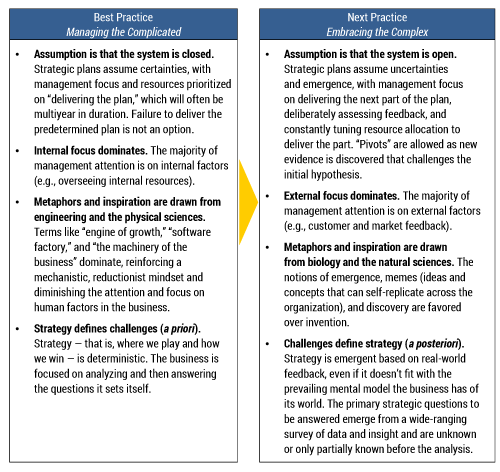
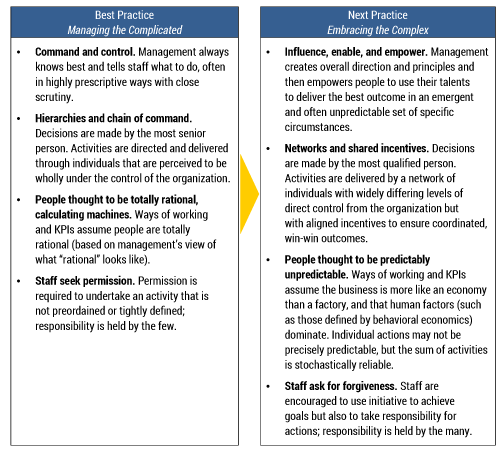
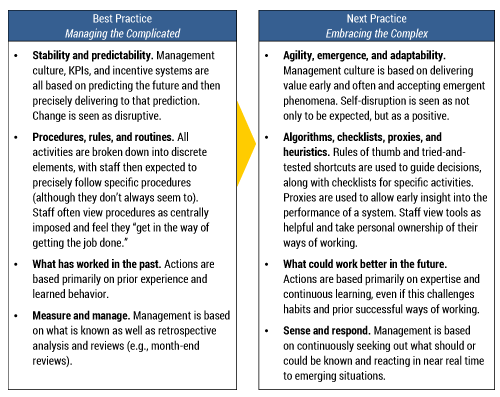
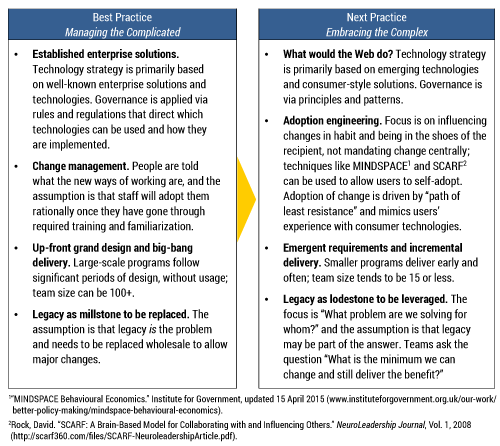
ENDNOTES
1 The term "next practice" has probably arisen independently multiple times, but we were first introduced to the concept by C.K. Prahalad.
2 "Cynefin".
3 Chapman, Jake. "System Failure." Demos, April 2002.


